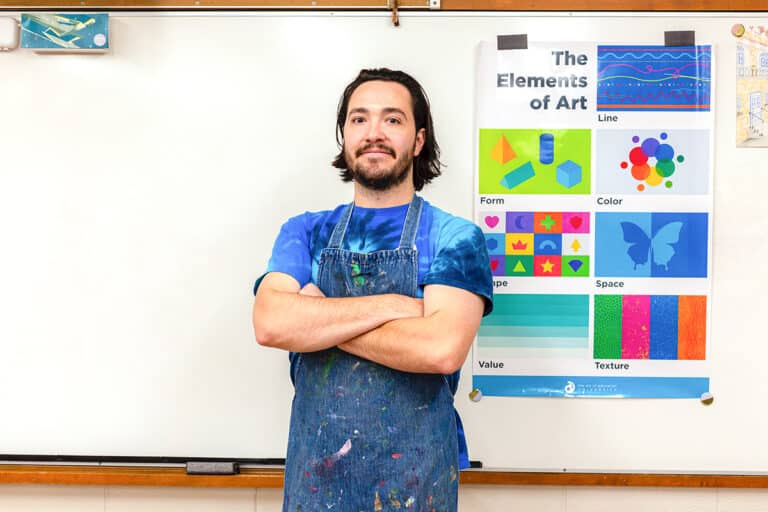Ah, student teaching. If you are like me, you can still recall the highlights (and lowlights) of your student teaching days. I will always remember when a veteran science teacher told me that a certain student I was struggling with would fit in the kiln–as if cooking a student was an acceptable solution. Needless to say, our student teaching experiences have a huge impact on our teaching.
Now, as a teacher, you may be on the other side of student teaching. You are the one guiding the next generation into the amazing world of art education. In my 14 years of teaching, I have had 3 student teachers and there are a few things I have learned.
Today I’d like to share 8 tips for hosting a student teacher in the art room.
1: Read all the information from the college.
The college I have worked with does a great job of sending out a supervising teacher packet the quarter before a student teacher starts. Even though all 3 of my student teachers have come from the same college, the requirements have changed for each of them. These changes have included what they expect from me, from the student teacher and how I am to turn in my supervising reports. Make sure you know what is expected of both of you!
2: Meet the student teacher before he or she starts.
You will most likely be given an information packet about your student teacher, but meeting in person is very important. An initial meeting is a great time for you to share any information you want your student teacher to know, to discuss your expectations and for the student teacher to share with you. Topics for this meeting include where to park at school, dress code, the student teacher’s out of school responsibilities and exchanging cell phone numbers or email addresses.
3: Outline a plan.
During the first day or two, you and your student teacher should outline when and how everything is going to happen. Some things to plan include co-teaching right away, extra teaching days (because things like snow days and deaths in a family can happen) and observation time at the end of student teaching where he or she can observe other teachers in the building.
4: Demonstrate good teaching.
If we’re being honest, we all know we let things slide from time to time. When you are a supervising teacher, you have to bring your “A” game every day. You have to be a good example for your student teacher in all your different roles at school. He or she will follow your example.
5: Co-Teach as much as possible.
Having the student teacher watch and watch and watch doesn’t really help him or her. Co-teaching helps the student teacher learn names, routines and teaching strategies without the requirements of lesson planning or grading.
6: Allow the student teacher to teach.
While this can be the hardest part, it is also the most important. During the planning part of student teaching, I share the concepts the students will need to cover during the student teacher’s time, but he or she is responsible for creating the lessons. While we are co-teaching, the student teacher is working on developing his or her own lessons. We spend a lot of time working through the pros and cons of the lessons, but ultimately, they have to be lessons that the student teacher creates. Your job is to help your student teacher learn how to teach what they want to teach, not to teach them them to copy what you have been doing.
Your job is to help your student teacher learn how to teach what they want to teach, not to teach them them to copy what you have been doing.
7: Provide support, reflection and guidance.
While my student teachers are teaching, I “hide” in the back of the room. I am close enough to hear and see what is going on but hidden enough that the kids forget I am there. I keep sticky notes of observations throughout the day and we discuss them as we go. Once a week we have a formal, sit-down evaluation where we discuss what is happening during the next week, what went well and what still needs work. Keep in mind that your student teacher is not you. He or she will do things differently. Your job is not to clone yourself, but to help him or her learn how to be a quality art educator.
8: Complete your requirements.
As your student teacher finishes his or her time in your classroom, is it easy to put off the last few things required of you as a supervising teacher. Complete all the paperwork for the college. Write your student teacher a letter of recommendation. Finally, take some time and reflect on what you have learned from your student teacher.
If you’re considering hosting a student teacher, I would wholeheartedly recommend it. I have been blessed with 3 good student teachers, one of which went on to become my long-term maternity sub. They each had different strengths and weaknesses, and they were all so much fun to work with.
What was the best part of your student teaching experience? Any funny stories? Anything you wished you had learned but didn’t?
What is keeping you from hosting a student teacher?
Magazine articles and podcasts are opinions of professional education contributors and do not necessarily represent the position of the Art of Education University (AOEU) or its academic offerings. Contributors use terms in the way they are most often talked about in the scope of their educational experiences.







